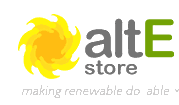We are no longer offering this product.
The below information is presented for informational purposes only. You may also find similar items in the category.- FEATURED PRODUCTS
- Solar Panels
- Solar Power Systems
- Productos Solares en Puerto Rico
- Charge Controllers
- Inverters
- Deep Cycle Batteries
- Solar Panel Mounts
- MORE PRODUCTS
- Cables & Wiring
- Enclosures, Electrical & Safety
- Inverter Power Panels & PreWired Systems
- Meters, Communications & Site Analysis
- Portable Power Systems
- Solar Water Pumps
- Voltage Converters
- Wind Turbines
- Books & Education
- * Clearance Sale *
- Hot Deals
- Open Box & Refurb Deals
Solar Boost 2000e, 25A, 12V Solar Charge Controller
| Item code | Brand name | Model number | Amps |
| BLSSB2000E-12V | Blue Sky Energy | SB2000E | 25A |
SB2000E Solar Boost solar charge controller 25 amps, 12 volts out. Wall mount box NOT included.
Be sure to design and size your system correctly with Blue Sky's Module Selection Guidelines.
 Blue
Sky Energy Blue
Sky EnergySolar Boost™ 2000E 25 Amp Peak Power Tracking Photovoltaic Charge Controller |
|

|
Solar Boost™ 2000E photovoltaic charge controller increases charge current up to 30% or more!Increase your solar panel output up to 30% or more with this new photovoltaic charge controller. Patent pending technology gives our controller the capability to use all the power your panels are capable of putting out. You could actually consider using less panels. When your batteries are low and you have sun you will get maximum power out of your panels. Under boost conditions it's like having an extra panel but without the cost and weight. |
- Patented MPPT Technology Increases Charge Current Up To 30% Or More!
- 25 amp capability supports large solar panel arrays
- Multi-stage PWM Charge Control Improves Battery Performance and Life
- Fully Automatic Electronic Current Limit Prevents Overload
- Equalize Function Keeps Lead-Acid Batteries Operating At Their Peak
- Durable Powder Coat Finish & Conformal Coated Electronics Resist Corrosion
- Full reverse polarity protection
- Selectable charge voltage charges flooded and gel type 12 volt lead acid batteries
- Automatic temperature compensation available as an option
- Charge Current Increase Can Save Money By Requiring Fewer Solar Panels
- Full 36 Month Limited Warranty
- Wall Mount Box must be purchased separately

SolarBoost™ 2000 (SolarBoost 2000E's predecesor model) is discussed in the popular "Things That Work" feature in Home Power Magazine's October 1999 issue. The article concluded,
"This charge controller and current booster is an ideal match ofr PV systems. During times of lowest battery voltage, the current is boosted the most. This is when it is most needed in PV systems. If you need a charge controller for a PV array of 20 amps of less, the Solar Boost 2000 is a good choice. We are looking forward to testing Solar Boost 2000's big brother, the Solar Boost 50."
The Alternative Energy Store also offers another maximum power point tracking (MPPT) solar controller, the 50 Amp Solar Boost™ 50.
Increase your solar panel output up to 30% or more with our new photovoltaic charge controller. Patent pending technology gives our controller the capability to use all the power your panels are capable of putting out. You could actually consider using less panels. When your batteries are low and you have sun you will get maximum power out of your panels. At times it can be like having an extra panel but without the cost and weight.
How Does Solar Boost 2000E Increase Charge Current?
A photovoltaic (PV) array is a constant current type device. As shown on a typical PV panel voltage-current curve, current remains relatively constant over a wide range of voltage. A typical 75 watt panel is specified to deliver 4.45 amps @ 17 volts. Traditional PV controllers essentially connect the PV array directly to the battery when the battery is not at a high state of charge. When this 75 watt panel is connected directly to a battery charging at 12 volts, the PV panel still provides about the same current. But, because PV output voltage is lower, it can only deliver 53 watts to the battery. This wastes a whopping 22 watts of available power!
Solar Boost 2000E 's patent pending technology operates in a very different fashion. Under these conditions Solar Boost 2000E calculates the peak power voltage at which the PV panel delivers maximum power, in this case 17 volts. It then operates the PV panel at 17 volts to extract maximum power. Solar Boost 2000E continually recalculates the peak power voltage as operating conditions change. We call this peak power tracking. Input power from the peak power tracking controller, in this case 75 watts, feeds a power converter which reduces the 17 volt input to battery voltage at the output. The full 75 watts delivered at 12 volts would produce a current of 6.25 amps. A charge current increase of 1.8 amps or 40% is achieved by converting the 22 watts that would have been wasted, into useable charge current. This example assumes 100% efficiency to illustrate the principal of operation. Actual boost will be less.
How Much Charge Current Increase Can I Expect?
The charge current increase you can expect is variable. Current increase varies with PV temperature and battery voltage. Lower PV temperature increases available power, while lower battery voltage increases current for a particular input power level. This means that the greatest current increase occurs when you need it most, in cold weather with a discharged battery!
What you can be sure of is that Solar Boost 2000E will deliver the highest charge current possible for a given set of operating conditions. When conditions are such that extra power is not available from the PV array, Solar Boost 2000E will operate as a high performance series pass PWM controller. Charge current increase field test results obtained using four 75 watt PV panels in southern California are shown in the table below. Your performance may vary due to a variety of factors.
Specifications
| Output current rating | 25A |
| System voltage | 12V nominal |
| Max PV Open Circuit Voltage | 30VDC |
| Output current limit | 25±0.5A |
| Voltmeter full scale range | 19.99V |
| Voltmeter accuracy at panel terminals | ± 0.10% full-scale |
| Current meter full scale range | 30A |
| Current meter accuracy | ± 0.75% full-scale |
| Standby current consumption | 17mA typical |
| PV on current consumption | 90mA typical |
| Output voltage adjustment range | 13 - 16V typical |
| Power conversion efficiency | 95% typical@ 15A |
| Temperature compensation coefficient | -30mV/°F (lead-acid) |
| -20mV/°F (NiCd, 10 cell)) | |
| Panel dimensions | 4.6"Hx6.4"Wx1.8"D |
|
Note: For optimal Maximum Power Point Tracking performance, it is recommended that MPPT charge controllers be used in conjunction with uniform solar arrays consisting of multiple, identical solar panels. MPPT charge controllers will still work with mixed arrays, but at reduced efficiencies, which defeats the whole point of MPPT technology. These devices were designed to calculate the most efficient charging characteristics given the assumption of a uniform array. Mixed arrays, by definition throw this calculation off.
|
|
Technical Bulletins
SB 2000E Equalization |
- In the box: BLSSB2000E-12V
In the box











